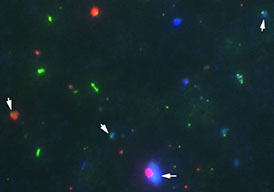Mixotrophy

Not all plankton fit neatly into the ecological categories of producer (plant) or consumer (animal). Some are what we call mixotrophs. Mixotrophs are organisms that can get their nutrition in two distinctly different ways (for instance, by using photosynthesis or by eating other organisms). Although we are not used to thinking about mixotrophs on land, they are actually very common in the ocean. In fact most major groups of phytoplankton (with the exception of diatoms and cyanobacteria) have at least one species (usually far more) that are mixotrophic.
My interest in mixotrophy started long ago on a cruise in the Equatorial Pacific. By incubating natural plankton communities with heat-killed, fluorescently-labeled bacteria we were able to look at which organisms were feeding on the bacteria. Using epifluorescence microscopy we were able to determine which cells were phototrophs (by looking at the fluorescence of chlorophyll within the cells) and which were not photosynthetic. The photo on the top right shows one of the images. The white arrows point to cells that ingested bacteria. Red colors show the fluorescence of chlorophyll within the cells (green shows fluorescence of a stain that binds to protein and blue shows fluorescence of a stain that binds to DNA). We found that half of the bacteria were ingested by phototrophic organisms that would normally be classified as phytoplankton (plants). Mixotrophs were very abundant and active (Stukel et al. 2011).
More recently, working with our colleague Dr. Karen Selph, we have taken samples to quantify mixotrophy in the waters of the Chatham Rise (New Zealand) and have plans to make similar measurements in the California Current Ecosystem. We are also working to incorporate phagotrophy into the GENOME model (Coles et al., 2017), which will allow mixotrophy to be an "emergent" property of this ecosystem model.
This portion of our website is specifically designed as outreach to the general public. If you are a scientist look for details about our research, please click on the red 'For Scientists' link on the top right.
Contact: Mike Stukel (mstukel@fsu.edu)
Florida State University
Dept. of Earth, Ocean, and Atmospheric Science
Center for Ocean-Atmospheric Prediction Studies
